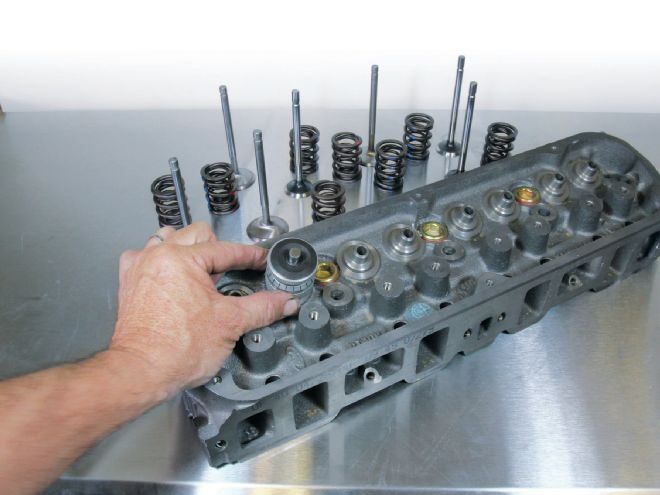
Last month, we showed you a buildup on Tim Moore's budget 5.0L Ford. We pulled it from the junkyard and added a Lunati hydraulic roller cam, some head mods, and an intake and carburetor and made a very impressive 375 real street horsepower. An important part of keeping the investment in line was retaining the production GT40P heads. These are Ford's best-flowing production cylinder head for the pushrod 5.0L. Due to space considerations, we didn't have room in the first story to detail all the tricks that went into these heads. Plus, as is usually the case, there are several ways to achieve those goals. The trick is to upgrade the valvesprings so the entire valvetrain can handle the lift and loads imparted by the longer-duration, higher-lift cam. But there's more to this than just swapping springs.
Let's start by reviewing the evolution of these heads. The GT40 first appeared in '93 and can be found on Mustang Cobras and Lightning pickups. This design was slightly reworked and installed on the '97-and-later Explorer and Mountaineer SUVs as the GT40P. The GT40 valve sizes are 1.85/1.54 for the intake and exhaust, while the GT40P went to a smaller 1.46-inch exhaust valve. There were other changes to the GT40P, including a slightly smaller combustion chamber reduced from 65 cc to roughly 60, which benefits the compression ratio. One of the biggest changes to the P heads was relocating the spark-plug placement to improve combustion efficiency. Unfortunately, this causes header-to-spark-plug interference when using standard small-block Ford headers with the GT40P head. There are a few headers out there that are designed specifically for the GT40P head, so you might want to check on that.
The GT40P incorporates a rotator into the exhaust valve retainer, which, through a series of ball bearings, allows the valve to rotate slightly each time it opens. This helps prevent exhaust valve seat erosion. The valve rotators are thicker than standard valvespring locators and retainers, though, and require a spring with a shorter installed height on the exhaust valve. The installed height is the distance from the valvespring seat in the head to the underside of the retainer. On these heads, the installed height of the intake valvespring is around 1.780 inch, but the exhaust is less at roughly 1.600 (the installed heights can vary by 0.050 inch or more). Because of this discrepancy, the exhaust valve's valve-lock groove must be shorter to allow sufficient room above the retainer for the guided rockers. This reduces the actual distance between the bottom of the retainer and the top of the valve guide and seal, so this combination can't accommodate any kind of performance cam with more than 0.450 inch of lift.
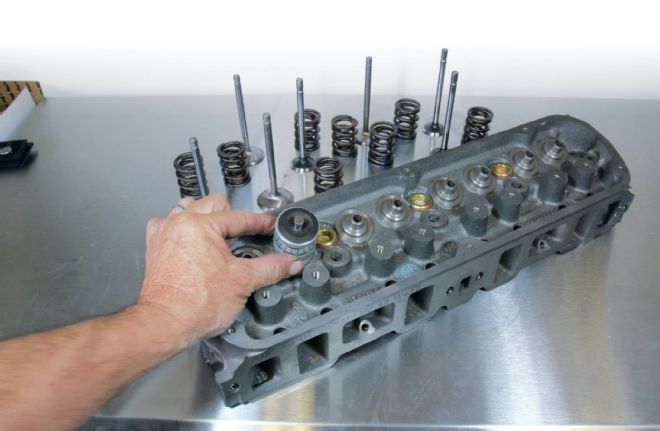
The production Ford GT40P iron head offers decent flow as a stocker, but it needs a few modifications in order to accommodate more valve lift.
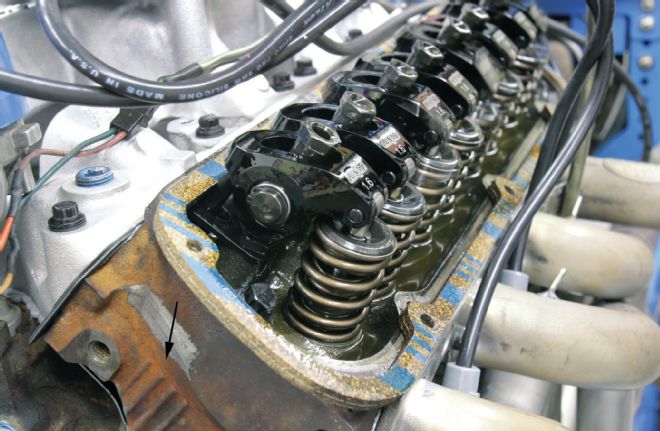
The easiest way to identify the GT40P head is these four vertical casting marks on the outside of the head. To verify, GT40P is also cast into the head (usually!) below the valve cover in the intake side of the head.
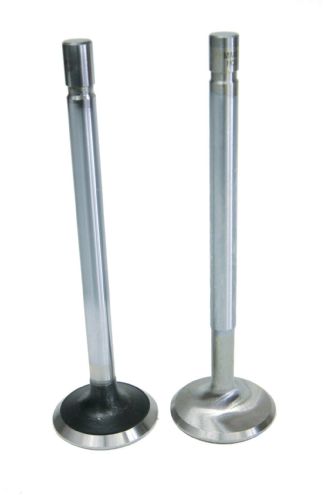
The keeper groove in the stock exhaust valve (left) is lower than with non-rotator-style valves because GT40P heads use shorter springs and a thicker retainer. We decided to use new valves from Manley (right) with keeper grooves in the same location as the intake valves, making assembly simpler and easier. Other valvespring kits compensate with different retainers or keepers to communize the installed heights.
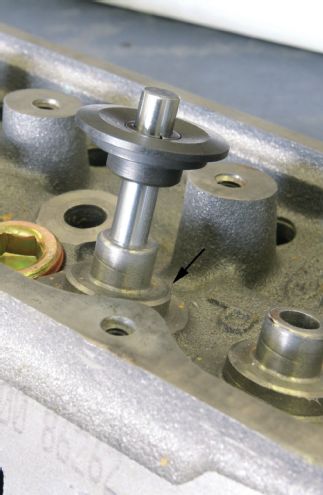
A valvespring's installed height is the distance between the spring seat and the bottom side of the spring retainer. In order to use the Lunati dual springs, this required machining the lower guide boss (arrow) to reduce its 0.990-inch O.D. to clear the inner spring, which has a 0.730-inch I.D. Slover's Porting Service did this machine work at the same time that the heads were ported and machined for screw-in studs.
These heads use a net lash valve system instead of a traditional stud-mounted, adjustable rocker. Net lash rocker stands use a bolt to position the rocker arms to the head, which is tightened to a preset position. This system is easier and quicker to install on the production line, but doesn't allow for lifter preload adjustment. Plus, the stock 5⁄16-inch retaining bolt is weak.
To make these heads work with a performance cam, Slover's Porting Service milled off the original net lash bolt pads to install 3⁄8-inch screw-in studs (with a 7⁄16-inch bolt size in the head) and changed the exhaust valve to ones with a taller keeper groove so the installed height would be consistent with the intake. This means the head would be able to use the same valvesprings, retainers, and keepers for all 16 valves. This conversion also required machining the guides to reduce their overall diameter to fit the 1.450-inch I.D. Lunati dual springs.
Of course, there are alternatives to this approach that can be accomplished without removing or machining the heads. Trick Flow Specialties makes a valvespring kit that allows you to retain the stock exhaust valves. It compensates for the installed height discrepancy by using different intake and exhaust valve retainers. Crane also sells a kit that includes beehive-style springs and offset valve locks. In this situation, Moore preferred to replace the stock exhaust valves with ones from Manley because they are stronger, and the benefits justified their additional cost.
Machining the guides allowed us to use a set of Lunati dual springs, because we intended to use a fairly aggressive cam and needed plenty of valve control at higher engine speeds. Our hydraulic roller cam was ground with at 231/239 degrees duration at 0.050 with 0.571/0.565-inch lift. As our testing revealed, this cam pushed the peak horsepower to 6,400 rpm, which means you might shift as high as 6,700–6,800 rpm in the car. That much rpm requires a strong valvespring.
The mods worked perfectly on Moore's budget small-block Ford that will soon find itself in a friend's early Mustang With a strong 375 hp. It should be a blast to drive, and we didn't pillage the piggybank to pull it off.
Parts List
Lunati valvesprings, 1.450-inch diameter 73100-16 Summit Racing $129.97 Manley exhaust valves 10723-8 Summit Racing 132.97 Comp Cams 3⁄8 rocker stud 4515 Summit Racing 59.97 Comp Cams guide plates, adjustable 4835-8 Summit Racing 54.97 TFS valvespring conversion kit 2500100 Summit Racing 169.97 Crane beehive spring kit for GT40P 44308-1 Summit Racing 178.80
Valvespring Chart
Spring PN Lunati 73100-16 Seat Load 125 lbs at 1.850 in Open Load 325 lbs at 1.250 in Coil Bind 1.110 in Spring Rate 333 lbs/in
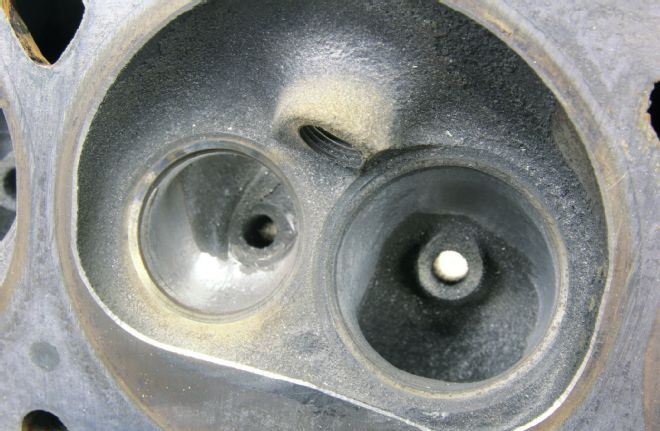
Mike Slover did all the machine work, including some light pocket porting to improve both the intake and exhaust flow by blending the bowl area under the seats into the main port. This careful blending takes a few hours but enhances flow across the entire valve lift curve through 0.550-inch. This work combined with the big Lunati cam made 375 hp at 6,400 rpm.
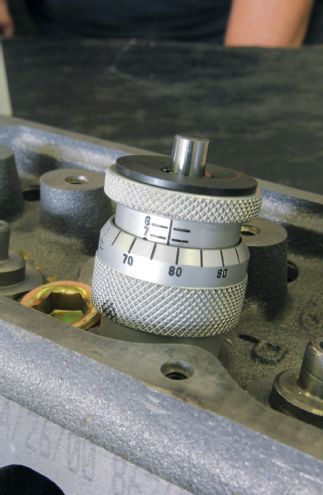
With new exhaust valves and a fresh valve job, we set the installed height of the springs with a simple installed checker tool you can buy from Summit Racing. With the stock valve, the installed height was too short at 1.775 inch. Using valves with taller keeper grooves, our installed height was 1.850, which put our spring load at 125 pounds on the seat and around 310 pounds at 0.570-inch max valve lift.
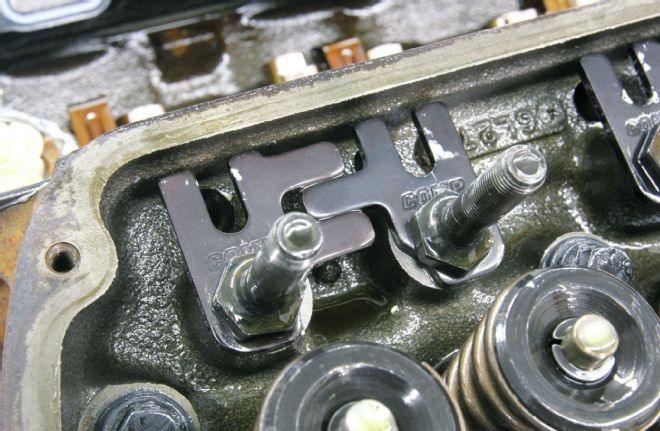
Comp Cams makes adjustable pushrod guideplates for the small-block Ford, which allows the builder to align each rocker arm over its valve. A fixed guideplate does not allow this kind of precision alignment. Once the rockers are properly centered over the valve, each stud is torqued in place.
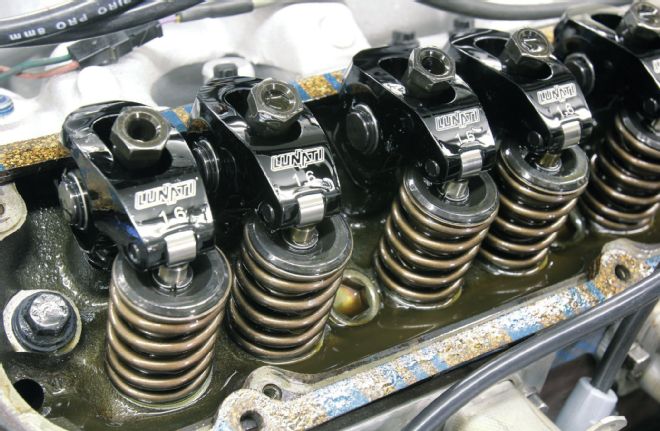
The remainder of the valvetrain was assembled with Comp 3⁄8-inch rocker studs, poly locks, and Lunati 1.6:1 roller rocker arms.